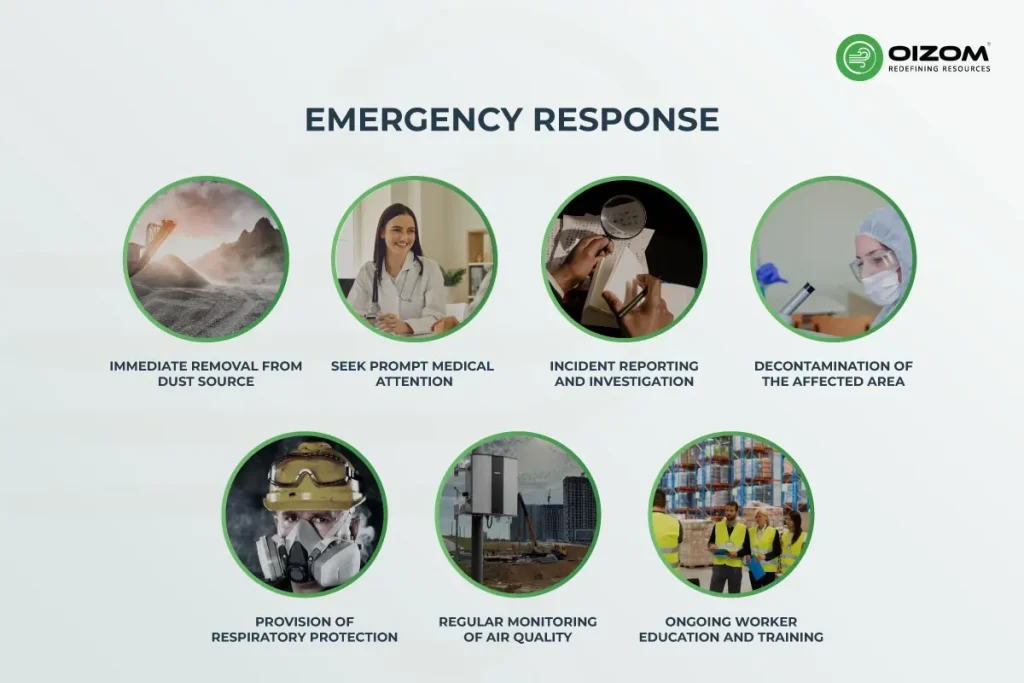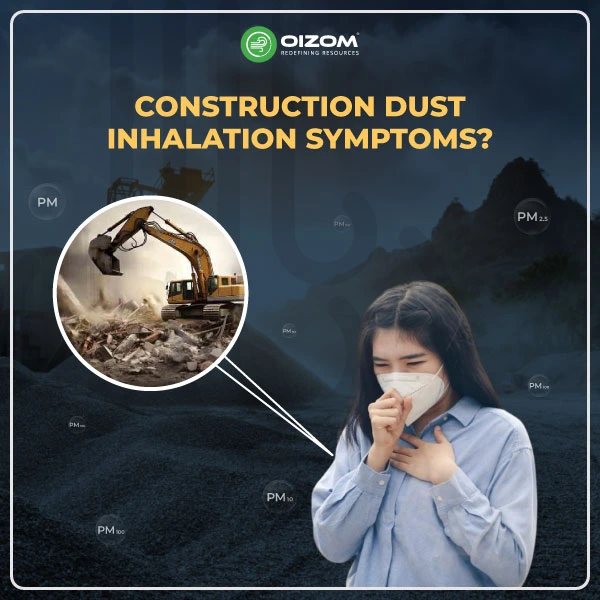Low and middle-income nations, primarily in Asia and Africa, account for over 90% of all air pollution-related deaths, followed by low and middle-income countries in the eastern Mediterranean region and Europe. Pollutants responsible for this form of pollution include construction trash, medical waste, IT waste, and industrial waste. We shall restrict the scope to pollution caused by construction wastes, namely “dust.”
The dust produced at the construction sites leads to several respiratory diseases, which eventually claim the lives of a wide range of workers across the globe.
According to WHO, air pollution is majorly responsible for non-communicable conditions, causing an estimated 24% of all deaths from heart disease, 25% from stroke, 43% from chronic obstructive pulmonary disease, and 29% from lung cancer.
It’s difficult to believe that something invisible to human sight may have such an impact on your general well-being. On the other hand, mould spores and building construction dust might cause adverse effects that can lead to significant health concerns. This blog post will discuss the link between the impacts of construction dust inhalation on human health, what symptoms to watch for, and what you can do to protect yourself.
Immediate Inhalation Symptoms
A less obvious but substantial threat hides in the dynamic environment of construction sites, where the noise of machines and tools echoes progress: construction dust. This byproduct, produced by routine construction activities such as cutting, grinding, and demolition, can cause a variety of immediate breathing symptoms known as “acute dust exposure.” These symptoms, which typically appear within hours of contact, are the body’s initial response to the invading dust particles, signifying the need for individuals to remove themselves from the dusty environment.
A. Short-term effects of inhaling construction dust
The short-term effects of inhaling construction dust can manifest quickly and are primarily respiratory, often serving as early warning signs of the potential harm caused by this workplace hazard. When construction workers or individuals near construction sites inhale dust generated from cutting, grinding, or demolishing, they are exposed to fine particles that can immediately impact their health.
1. Coughing and throat irritation
Coughing and sore throats are the most prominent signs of dust inhalation. This reflexive action is the body’s natural defence against the intrusion of foreign particles. When dust particles irritate the delicate cilia lining the respiratory tract, the body instinctively reacts with a cough. This action, a forceful expulsion of air, helps clear the airways, preventing the dust from delving deeper into the lungs, thereby serving as a crucial protective mechanism.
The throat, serving as the primary entry point for inhaled air, often endures the initial impact of dust inhalation. When construction dust particles come into contact with the throat’s lining, they can irritate, leading to sensations of scratchiness or soreness. This irritation is often accompanied by a dry cough, an additional effort by the body to expel the irritants and ease the discomfort.
2. Shortness of breath
As dust particles navigate more profoundly into the respiratory system, they can cause the airways to become inflamed and narrow, making it difficult for air to pass through. This can lead to shortness of breath, where drawing a full breath becomes a struggle. Dust triggers an inflammatory response, leading to swelling in the airways and resulting in breathlessness, often accompanied by wheezing or a tight sensation in the chest.
3. Chest tightness
Chest tightness is another common symptom of acute dust exposure. This sensation often arises from the muscular constriction around the chest as a response to the disrupted breathing rhythm caused by the dust particles. The feeling of tightness or pressure in the chest is further magnified during attempts to inhale deeply, as the inflamed and constricted airways hinder the free flow of air.
Delayed Inhalation Symptoms
Delayed inhalation symptoms from construction dust exposure often emerge over time and can be more severe than their immediate counterparts, highlighting the insidious nature of prolonged exposure to construction dust. Unlike the acute reactions that occur soon after exposure, these symptoms develop gradually, often going unnoticed until they become significant health issues.
A. Long-term consequences of prolonged exposure
The long-term consequences of prolonged exposure to construction dust often manifest as more severe and enduring health issues than their immediate counterparts. These delayed inhalation symptoms, known collectively as “chronic dust exposure,” can emerge years after initial exposure, underscoring the insidious nature of construction dust and the critical importance of sustained vigilance.
1. Chronic cough
Chronic cough, a persistent and lasting symptom, is one of dust exposure’s most common long-term effects. It is a cough that persists for more than eight weeks, often accompanied by mucus production. The persistent nature of this cough stems from the continuous irritation and inflammation caused by dust particles lodged deep within the lungs. This relentless cough not only disrupts daily life, impacting sleep and daily activities, but it also signifies ongoing respiratory distress, potentially indicative of more severe conditions.
It could indicate a mould illness if you’re chronically sneezing, coughing or wheezing. More serious conditions include aspergillosis, which can be mild to severe, and hypersensitivity pneumonitis, which can lead to pulmonary fibrosis if left untreated.
2. Development of respiratory diseases (e.g., bronchitis, asthma)
Another significant long-term risk associated with chronic dust exposure is the development of bronchitis. This condition involves airway inflammation, leading to coughing, wheezing, and chest tightness. The dust particles irritate the airway lining, sparking an inflammatory reaction that increases mucus production and airway swelling. This can lead to difficulty breathing and a reduced ability to clear airways, exacerbating the risk of further respiratory infections.
Asthma is one of the most common health problems that many construction workers suffer. Inhaling dust, gases, and fumes produced while cutting holes and cuts in concrete and masonry constructions causes it. In demolition operations, dust output is high, severely affecting workers. Because demolition and construction workers are exposed to a lot of dust, it affects their productivity and can lead to health issues like Asthma.
Among the most severe outcomes of chronic dust exposure, particularly to silica dust, is silicosis. This irreversible lung disease is marked by scarring of the lung tissue, which severely impairs lung function. Symptoms include persistent shortness of breath, chest tightness, and a reduced capacity for physical activity. As the disease progresses, it can lead to critical complications like lung failure, necessitating intensive treatments such as oxygen therapy or even lung transplantation.
Other Health Impacts
The health impacts of construction dust inhalation extend beyond the well-known respiratory ailments, infiltrating other aspects of physical well-being. This complex mixture of fine particles, a byproduct of various construction activities, poses risks not only to the lungs but also to the skin, eyes, digestive system, and cardiovascular system. Understanding and addressing these broader health impacts is crucial in safeguarding the well-being of those exposed to construction environments.
Skin Irritation: The Unseen Barrier Breach
The abrasive nature of construction dust can be particularly harsh on the skin, leading to irritation, dryness, and redness. As these particles come into contact with the skin, they can disrupt its natural protective barrier, resulting in inflammation and discomfort. With prolonged exposure, individuals might experience more severe skin conditions like eczema and dermatitis, characterised by symptoms such as itching, redness, and skin cracking.
Eye Irritation: Dust’s Blinding Impact
The eyes, sensitive and crucial for daily functioning, are also vulnerable to construction dust. Particles can enter the eyes through direct contact or indirectly, such as through rubbing the eyes with contaminated hands. This can lead to irritation, redness, and dryness, with the potential risk of developing conjunctivitis – an inflammation of the conjunctiva, the membrane lining the eyelids. Symptoms include redness, itching, and excessive tearing, impacting vision and comfort.
Cardiovascular Concerns: The Hidden Hazard
Emerging studies indicate a link between construction dust exposure and an increased risk of cardiovascular diseases, including heart disease and stroke. When inhaled, dust particles can enter the bloodstream and contribute to inflammatory and oxidative stress processes. These processes play a role in atherosclerosis, the hardening and narrowing of arteries, potentially leading to serious cardiovascular events such as heart attacks and strokes.
Digestive problems: a surprising result
While eating mouldy foods is more likely to cause gastrointestinal problems, mould spores and dust can also cause them.
Diarrhoea, nausea, and loss of appetite are among the complaints. Weight loss is generally caused by stomach discomfort, but weight gain can also be a symptom of mould and your health. According to mould expert Dr. Mark Hyman, head of the Cleveland Clinic Centre for Functional Medicine, toxins can induce your immune system to manufacture antibodies that affect your metabolism.
Depression: An indirect but natural reaction
The connection between mould and your health isn’t limited to physical ailments. Depression and sadness are indirect but natural reactions to mould and dust exposure. These conditions often arise when you feel you have no control over your environment.
Prevention and Protection
Combining individual and workplace prevention and protection strategies is essential to counter the diverse health risks of construction dust effectively.
Individual Measures for Personal Defense
- Personal Protective Equipment (PPE): Workers should wear appropriate PPE, such as respirators, dust masks, and gloves, to form a barrier against dust particles.
- Hygiene Practices: Regular washing of hands and exposed skin after work can remove dust particles, reducing the risk of skin and eye irritation.
- Avoiding Contact: Minimizing direct contact with the eyes and the respiratory tract is crucial to prevent irritation and inflammation.
Workplace Measures for Collective Safety
- Dust Suppression Techniques: Water misting and wetting down materials can significantly reduce dust generation.
- Regular Cleaning: Implementing thorough cleaning practices helps in removing dust accumulation.
- Air Filtration Systems: HEPA filters can effectively capture airborne dust particles, enhancing air quality.
- Adequate Ventilation: Ensuring proper ventilation helps remove dust from the work environment.
- Worker Education: Informing workers about the risks and training them in prevention measures is vital for a comprehensive defence strategy.
Adopting a proactive approach that combines individual and workplace measures is critical to mitigating the health risks associated with construction dust inhalation. Education, proper PPE use, and effective dust control strategies can create a safer and healthier environment for everyone involved in construction activities. This approach addresses immediate health concerns and contributes to long-term well-being, ensuring holistic protection against the multiple effects of construction dust.
Emergency Response

Acute dust exposure incidents in dynamic and often hazardous construction environments require immediate and effective emergency response procedures. These measures are crucial for the immediate well-being of the affected individuals and play a significant role in preventing long-term health consequences and ensuring a safer work environment.
Immediate Removal from Dust Source
The first and foremost step in responding to an acute dust exposure incident is to remove the affected individual from the vicinity of the dust source. This immediate action is crucial to prevent further exposure. If necessary, the individual should be relocated to an area with fresh, clean air and escorted to a medical facility for further evaluation and treatment.
Seek Prompt Medical Attention
In cases where the individual experiences severe symptoms such as difficulty breathing, chest pain, or persistent coughing, seeking prompt medical attention is imperative. Timely medical intervention can be pivotal in preventing the progression of respiratory issues that could arise from dust inhalation.
Incident Reporting and Investigation
Reporting any dust exposure incident to the appropriate authorities, like the site supervisor or safety officer, is essential. Reporting not only ensures that the incident is documented but also initiates an investigation into the cause, thereby enabling the implementation of corrective measures to prevent similar occurrences in the future.
Decontamination of the Affected Area
Following the removal of the individual, steps should be taken to decontaminate the area where the dust exposure occurred. This process might involve cleaning with HEPA-filter-equipped vacuum cleaners, employing wet methods to suppress dust, and ensuring thorough ventilation of the area.
Provision of Respiratory Protection
In the aftermath of an exposure incident, it is vital to provide all workers in the affected area with adequate respiratory protection equipment. This may include respirators or dust masks and is essential to prevent further exposure until the dust levels are controlled.
Regular Monitoring of Air Quality
Maintaining safe air quality levels in the workplace is crucial, and this involves regular monitoring. Using Oizom air monitoring devices or conducting periodic assessments can help ensure that the air quality remains within safe limits.
Ongoing Worker Education and Training
Equally important is workers’ ongoing education and training about the hazards associated with construction dust inhalation. Understanding the importance of emergency response procedures and being prepared to act can foster a culture of safety and awareness among the workforce.
Conclusion
The persistent challenge of construction dust inhalation in our ever-evolving landscapes calls for a concerted effort to mitigate its harmful effects on human health. The repercussions of dust exposure in construction sites extend far beyond immediate discomfort, posing long-term health risks that can be severe and weakening. The spectrum of health hazards ranges from chronic respiratory diseases to skin and eye irritation and even extends to increased cardiovascular risks, all stemming from prolonged exposure to construction dust.
A comprehensive and multi-pronged approach is essential to combat these health hazards. This strategy must encompass elements of prevention, protection, and education, aiming to minimise exposure and ensure the health and safety of both workers and the surrounding community.
Addressing the multifaceted challenges of construction dust requires a unified effort involving workers, employers, policymakers, and the public. Through a blend of collaboration, innovation, and a comprehensive understanding of the associated health risks, it’s possible to transform construction sites into safer environments. This collaborative endeavour is not just about progress in construction practices; it’s about advancing towards a future where the well-being of all is prioritised. By working together, we can aspire to an end where construction dust is no longer a hidden threat but a challenge effectively addressed and managed, contributing to healthier communities and a safer working environment for everyone involved in the construction industry.






